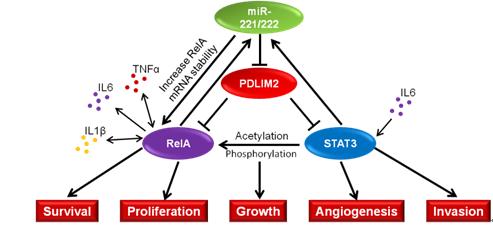
Scientists Reveal New Mechanism Underlying Constitutive Activation of NFκB and STAT3 in Human Colorectal Cancer
Jul 01, 2014 Email"> PrintText Size

Colorectal cancer (CRC) ranks the third in morbidity and fourth in mortality out of all human cancers worldwide. It has been increasingly documented that chronic inflammation promotes human CRC development and progression. Constitutive activation of NFκB and STAT3 pathways in human colorectal cancers links inflammation to CRC development and progression. However, the underlying mechanisms remain to be elucidated.
Dr. LIU Sanhong and Ph.D. candidate SUN Xiaohua, supervised by Dr. ZHANG Xiaoren from the Institute of Health Sciences (IHS) revealed that miR-221/222-mediated positive feedback loop played an important role in the constitutive activation of inflammatory signals and the development of colorectal cancer. This work was conducted in collaboration with Prof. WANG Mingliang from the Ruijin Hospital Affiliated to Shanghai Jiao Tong University.
Researchers discovered that miR-221 and miR-222 positively regulated both NFκB and STAT3 activities, which in return induced miR-221/222 expression, creating a positive feedback loop in human CRCs. miR-221/222 directly bound to the coding region of RelA, leading to increased RelA mRNA stability. In addition, miR-221/222 reduced ubiquitination and degradation of RelA and STAT3 proteins by directly targeting the 3' UTR of PDLIM2 mRNA, an E3 ligase for both RelA and STAT3, collectively upregulating RelA and STAT3 protein.
The study demonstrated that disruption of the positive feedback loop suppressed human CRC cell growth in vitro and in vivo. miR-221/222 expression correlated with the expression of RelA, STAT3 and PDLIM2 in human CRCs. These findings defined a novel mechanism underlying constitutive activation of NFκB and STAT3 pathways in human CRCs, revealing miR-221/222 served as novel potential therapeutic targets for CRCs.
The work entitled “A microRNA 221- and 222-mediated feedback loop, via PDLIM2, maintains constitutive activation of NFκB and STAT3 in colorectal cancer cells”, was published on line in Gastroenterology on June 12, 2014. The project was supported by the Ministry of Science and Technology of China, the National Natural Science Foundation of China, China Academy of Sciences. Prof. HOU Yingyong from the Zhongshan Hospital Affiliated to Fudan University also provided supports for this project.
Schematic representation of the proposed miR-221/222-NF-κB-STAT3 feedback circuit in human CRC development and progression (Image by Dr. ZHANG Xiaoren’s group)
Contact:
ZHANG Xiaoren
Key Laboratory of Stem Cell Biology, Institute of Health Sciences, Shanghai Institutes for Biological Sciences, Chinese Academy of Sciences and Shanghai Jiao Tong University School of Medicine,
Shanghai 200031, China
E-mail: xrzhang@sibs.ac.cn
Colorectal cancer (CRC) ranks the third in morbidity and fourth in mortality out of all human cancers worldwide. It has been increasingly documented that chronic inflammation promotes human CRC development and progression. Constitutive activation of NFκB and STAT3 pathways in human colorectal cancers links inflammation to CRC development and progression. However, the underlying mechanisms remain to be elucidated.
Dr. LIU Sanhong and Ph.D. candidate SUN Xiaohua, supervised by Dr. ZHANG Xiaoren from the Institute of Health Sciences (IHS) revealed that miR-221/222-mediated positive feedback loop played an important role in the constitutive activation of inflammatory signals and the development of colorectal cancer. This work was conducted in collaboration with Prof. WANG Mingliang from the Ruijin Hospital Affiliated to Shanghai Jiao Tong University.
Researchers discovered that miR-221 and miR-222 positively regulated both NFκB and STAT3 activities, which in return induced miR-221/222 expression, creating a positive feedback loop in human CRCs. miR-221/222 directly bound to the coding region of RelA, leading to increased RelA mRNA stability. In addition, miR-221/222 reduced ubiquitination and degradation of RelA and STAT3 proteins by directly targeting the 3' UTR of PDLIM2 mRNA, an E3 ligase for both RelA and STAT3, collectively upregulating RelA and STAT3 protein.
The study demonstrated that disruption of the positive feedback loop suppressed human CRC cell growth in vitro and in vivo. miR-221/222 expression correlated with the expression of RelA, STAT3 and PDLIM2 in human CRCs. These findings defined a novel mechanism underlying constitutive activation of NFκB and STAT3 pathways in human CRCs, revealing miR-221/222 served as novel potential therapeutic targets for CRCs.

Schematic representation of the proposed miR-221/222-NF-κB-STAT3 feedback circuit in human CRC development and progression (Image by Dr. ZHANG Xiaoren’s group)
Contact:
ZHANG Xiaoren
Key Laboratory of Stem Cell Biology, Institute of Health Sciences, Shanghai Institutes for Biological Sciences, Chinese Academy of Sciences and Shanghai Jiao Tong University School of Medicine,
Shanghai 200031, China
E-mail: xrzhang@sibs.ac.cn
CAS Institutes
There are 124 Institutions directly under the CAS by the end of 2012, with 104 research institutes, five universities & supporting organizations, 12 management organizations that consist of the headquarters and branches, and three other units. Moreover, there are 25 legal entities affiliated and 22 CAS invested holding enterprisesThere are 124 I...>> more
Contact Us

Chinese Academy of Sciences
Add: 52 Sanlihe Rd., Xicheng District, Beijing, China
Postcode: 100864
Tel: 86-10-68597592 (day) 86-10-68597289 (night)
Fax: 86-10-68511095 (day) 86-10-68512458 (night)
E-mail: cas_en@cas.cn

